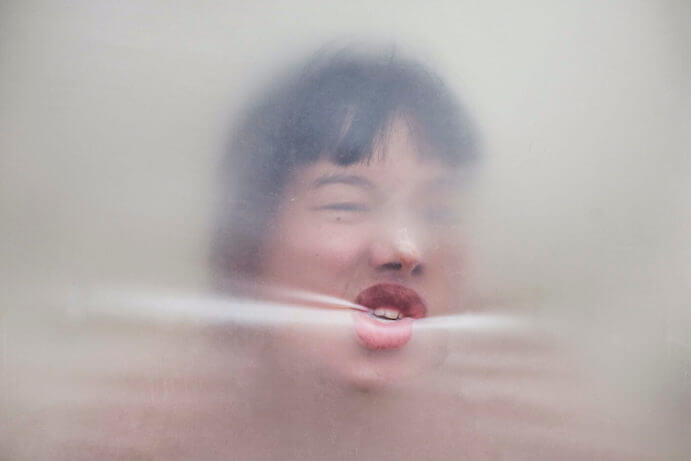Attempting to confine Charmaine Lee’s vocal stylings to any particular genre or, dare I say, combination of adjectives is somewhat of a fool’s errand. Her debut record, released March 19, 2021 by Erratum Musical, is no exception. KNVF is a follow-up to Lee’s 2018 debut tape, Ggggg (Anticausal Systems), and exhibits explosive evolution from the latter’s subtle delicacy into an expansive world of fuzz-laden noise and profound space. As Lee demonstrates, our bodies are quite literally musical instruments. Assisted by various forms of amplification and sound processing electronics, what Lee brings forth is a dissection of the sounds we often produce and encounter, distilling them into a very personal elixir.
Human beings are possessed by subtleties in sound, particularly when transmitted by the voice. We fixate over the abundant lip-smacking of announcers on the radio, while our hair stands on end when someone whispers in our ear. Clicks, pops, trills and whistles that emerge from the throat and take shape in the mouth manifest as song and speech, cries of elation, or calls of distress. Lee’s uncompromising improvisations show us that the barriers between these modes are thin and transparent. Without the need to sing a note nor utter a word, music is created and narratives unfold. Indeed, there are moments throughout KNVF that induce a feeling of, “what the heck am I listening to?” So much physicality is expressed it feels almost like a betrayal to simply hear it without experiencing Lee’s methods of sound production first hand with all possible senses. The listener is at times overwhelmed by the need to decode what they are hearing.

However, to suggest Lee’s work is mere abstraction or performatively avant-garde overlooks its primordial and spiritual qualities. Inuk artist Tanya Tagaq comes immediately to mind as a potential kindred spirit. While Tagaq’s work is an individual expression of her ancient cultural heritage (that of Inuit throat singing), it is possible to draw parallels between these artists and their unfettered confidence in aural storytelling. Lee seems to create a mythology of her own that resonates with ancient vocal traditions but does not appropriate nor borrow at the risk of becoming a gimmick. There is humor to it, but it’s serious; exciting, exuberant, often joyous, and in many ways transcendent.
Embedded in the fuzz and distortion, a delight in language seems also to play a role in Lee’s mouth-sound explorations. A series of phrases in “Exuberant Bodies (For Yan Jun)” at first seem only to imply fragments of language, like a coded message. While heavily veiled, there is in fact text, which is taken from a work called “Exuberance with bloody hands” by late Australian poet Dorothy Porter.
There is an implication that some of KNVF’s material emerges from the twisting of phonemes to a point where the meaning of a word is reabsorbed into the raw sounds from which it is produced. Even the track titles offer a satisfying exercise in aesthetic wordplay and acrobatic diction. It’s fun to say them out loud. My favorite track, “Jullyfeeush,” which I admit to speaking aloud again and again until the word I thought I was saying started to sound utterly alien; more like music than speech.

“Residual Pulse” presents more synthetic textures as waves of overdriven static and feedback distort Lee’s voice and conjure illusions of plucked strings, bells, and bowed metal. It becomes increasingly difficult to pinpoint where or if Lee’s voice ends and the electronics take over. Meanwhile, “Market Slip” falls somewhere between Morse Code and a warm-up exercise performed by a cartoon opera singer. In all, KNVF’s eleven tracks form a compelling and cohesive arc from the crunchy glitches of “Monstas’ Marriage” perforated by silence, through to the screaming intensity of “The Final Futz,” which sounds like a distant radio transmission.
The quality of the physical release perfectly complements the sophistication of Lee’s work. The 180g 12-inch 45rpm disc is enclosed in a clean and simple sleeve with a single insert listing credits and track data. The record is protected by a static-free inner sleeve, which is a discreet mark of quality that officiates its audiophile appeal. Eye-catching cover art shows a 3×3 matrix of photographs (credited to Luke Cheng) that depict Lee emoting wildly. Each image is distorted by digital artifacts that roughly suggest motion. This fractured freeze-framing results in a concise visual depiction of Lee’s sound making process, almost like a musical score.
The counterpoint between Ggggg (Anticausal Systems) and KNVF shows a compelling trajectory of revelation. Lee’s raw energy makes for a listening experience that is both shockingly fresh on an intellectual level and curiously familiar and relatable on a more instinctual level. It seems the music that Lee uncovers is somehow in all of us, but can only be channeled through those, like herself, of exceptional ability.
I CARE IF YOU LISTEN is an editorially-independent program of the American Composers Forum, funded with generous donor and institutional support. Opinions expressed are solely those of the author and may not represent the views of ICIYL or ACF.
A gift to ACF helps support the work of ICIYL. For more on ACF, visit the “At ACF” section or composersforum.org.
























